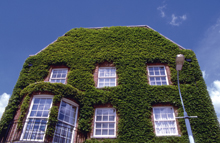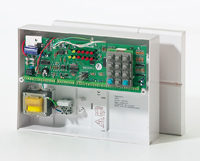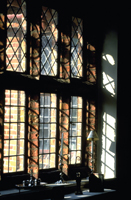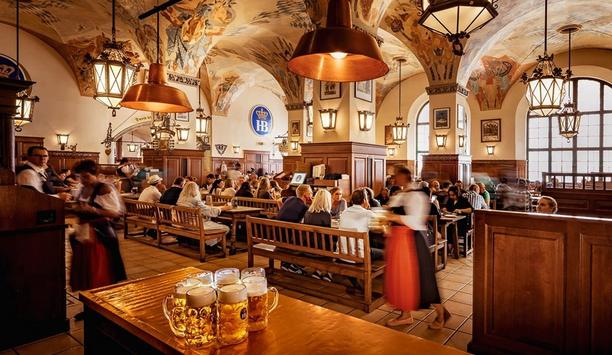The National Trust is one of Britain's leading conservation charities, protecting over 200 historic houses, together with their collection of objects, paintings and furniture assembled by the families who previously lived there.
As well as houses, the National Trust owns approximately 160 gardens, 245,000 hectares of countryside including much in the Lake District, and almost 600 miles of coastline.
The houses are open to the public from April to October, five days a week, admitting an average of 11 million visitors a year. The types of houses range from stately homes with 50 to 60 or more rooms, to small two up, two down cottages of historical interest. All are under constant threat of attack from opportunist and occasionally "professional" thieves.
Peter Gough and Dominic Pearson are responsible for the security at the National Trust. They are tasked with crime prevention and detection of break-ins at the earliest possible stages to prevent further damage and losses. They are assisted by 20 retired Police Officers, who work for the Trust on a voluntary capacity to follow up security incidents.
Having joined the Trust in 1995 as the second in-house Security Manager, Peter's main responsibilities are to give the correct professional advice; conduct the risk and threat assessment at each site and then provide the line managers with a security strategy for their approval, which encompasses physical, electronic and procedural security. Peter comments: "We also audit existing measures so that we can make specific recommendations. We bring their security up to a level which meets the strategy, and that might include a new alarm system."
Between five and six hundred alarm systems have been installed throughout Trust buildings. In some of the larger properties there are over 400 sensors and detection devices. Peter now uses a hybrid combination of wired and wireless sensors, as well as audio sensors to provide dual confirmation in line with the requirements of DD243.
 Each property contains one or more alarm systems as many of the houses are furnished with items worth thousands or even millions of pounds. Although there may be few things of value in some of the smaller properties, it is still important to know if someone is trying to break in. Irrespective of "sales value" the contents have an importance related to the property. For example, Winston Churchill's fountain pen, which is on display at Chartwell, is not valuable as a fountain pen, but the fact that it belonged to Winston Churchill makes it a unique item associated with that particular place. Peter stresses: "All our properties and all their contents are important to us."
Each property contains one or more alarm systems as many of the houses are furnished with items worth thousands or even millions of pounds. Although there may be few things of value in some of the smaller properties, it is still important to know if someone is trying to break in. Irrespective of "sales value" the contents have an importance related to the property. For example, Winston Churchill's fountain pen, which is on display at Chartwell, is not valuable as a fountain pen, but the fact that it belonged to Winston Churchill makes it a unique item associated with that particular place. Peter stresses: "All our properties and all their contents are important to us."
From time to time false alarm activations occur, causing a headache for Peter in light of the current ACPO policy. The ACPO policy classifies all sites in the same way; and basically it considers them all with the same risk. Peter argues that different circumstances for different organisations or types of buildings should be taken into account individually and that a National Trust building with hundreds of sensors cannot be considered equal to a corner shop with less than ten sensors. He explains: "Most stately homes are big houses with many rooms. They are old properties and despite ones best intentions the windows and doors don't all fit perfectly and you can have problems with bats getting in under doors or down chimneys triggering the alarms. Not only are the contents worth millions of pounds, but they cannot be replaced on a like for like basis. Even if we got the insurance money for a painting or other item that had been stolen we couldn't go out and buy the same item again. Once it's gone, it's gone. So the level of risk in one of our properties is much higher than that of a corner shop. However, the ACPO Policy says if you have two false alarms you are down on Level 2 response; five false alarms and you are out!"
Peter continues: "Today risk management is the name of the game and so we, and the service providers, should be doing just that. I'm not asking for special treatment for the National Trust or any other organisation. What I'm saying is that providing we can demonstrate that we are doing all we possibly can to manage our false alarm situation, to examine every alarm activation in detail and to take remedial measures, then we would hope that the Police will understand our position and work with us to manage risks by continuing to give us a response. In fact, I would have no problem with paying a charge for a call out to a false alarm."
In the National Trust buildings, conservation is the raison d'être; Peter has had to find ingenious ways of introducing alarm systems with the least amount of interference or disruption. There are many challenges, where, for example the room has a stone or marble floor, or the walls have a delicate leather décor that cannot be tampered with. To get around these situations Peter uses a hybrid arrangement of radio and wired sensors.
 Movement and other detectors are fitted in the principal state rooms open to the public. These are positioned discreetly, to reduce the visual impact for visitors, yet remain visible enough to act as a deterrent to the thief. It is taken for granted that criminals will come in and look around at possible items to steal. They will target rooms with valuable objects. Microphones are fitted in each of these rooms to provide audio verification, and vibration detectors are fitted to the windows to catch early activation. Peter explains: "The other thing we do is control the walk test indicators from the control panel for two reasons. Firstly we don't want the walk test indicators flashing away because it is a visual disturbance when you are trying to appreciate the room. And secondly so that the potential thief cannot determine the coverage of the sensor. Staff can enable the walk test indicators from the control panel and do the walk test on the room."
Movement and other detectors are fitted in the principal state rooms open to the public. These are positioned discreetly, to reduce the visual impact for visitors, yet remain visible enough to act as a deterrent to the thief. It is taken for granted that criminals will come in and look around at possible items to steal. They will target rooms with valuable objects. Microphones are fitted in each of these rooms to provide audio verification, and vibration detectors are fitted to the windows to catch early activation. Peter explains: "The other thing we do is control the walk test indicators from the control panel for two reasons. Firstly we don't want the walk test indicators flashing away because it is a visual disturbance when you are trying to appreciate the room. And secondly so that the potential thief cannot determine the coverage of the sensor. Staff can enable the walk test indicators from the control panel and do the walk test on the room."
System maintenance and upgrades are carried out during the winter months when the buildings are closed to the public. It's a busy time and requires careful planning, as maintenance work is not straightforward in a National Trust building. The simple task of running cable under floorboards is a conservation nightmare because of the dust it creates. Furniture needs to be moved and carefully stored, adding to the cost of the job. Any items remaining in the room such as paintings or large pieces of furniture need to be covered to protect them from dust. If the installers are bringing in ladders they will need to put protection on the walls and floors too. This type of project can take several weeks of careful work with just two people from the alarm company and someone from the Trust's direct labour team in attendance to lift boards and assist as necessary. The cost of conservation works can be equivalent to or more than the cost of replacing the alarm system. Wherever possible Peter will try to minimise conservation costs and only spend on the actual alarm system. This is achieved by using existing wiring from Rios to sensors, which eliminates a lot of the building works.
This winter one of the stately homes will undergo maintenance to replace the existing control panel with a Galaxy control panel from Honeywell Security. The existing panel is non-standard and has been causing continual problems. It's a combination of the state of the electronics, that are quite old, and the state of the main data highway. The wiring is probably 20 plus years old, and one of the problems has come about because new equipment has been connected to old wiring, with brittle wires or wires that are corroding. So essentially the electronics is not robust, the data highway wiring is not in good order and there have been a number of false alarm problems from it. Peter has decided to put a new control system in and replace the data highway. This will involve taking out the existing equipment, but retaining the Rio to sensor wiring. This involves testing it by measuring its insulation resistance between each core and core and ground on the sensor wiring. Ideally if the wiring is still in good order Peter will want to reuse it.  To replace all the wiring will involve major building works; burying cables into walls, taking up floorboards and other costly measures. Replacing the data highway can be done in behind the scenes areas.
To replace all the wiring will involve major building works; burying cables into walls, taking up floorboards and other costly measures. Replacing the data highway can be done in behind the scenes areas.
Galaxy is the standard control panel used in almost all of the Trust properties. Peter specifies Galaxy having become disenchanted with companies installing proprietary panels, which ties the Trust in to those companies for ongoing maintenance and monitoring.
Peter comments: "Quite frankly they were not performing and I wanted the freedom to go somewhere else. We chose to use Galaxy because it is a non-proprietary panel and provides all of the features we need. We've been using it for many years and continue to use it because various generations of the Galaxy panel are backwards compatible with previous generations. The Galaxy panel also keeps up with the changing requirements of the European Standards and the ACPO Policy. We also take note of what other large companies use, such as major retailers, who also use them. We know Honeywell will support these larger organisations and we will therefore enjoy a similar position. Also by standardising with Galaxy control panels we show Honeywell that we are worth supporting in our own right. If we have a problem we can rely on them to assist us, as well as the installer."
Alarm systems are monitored at external Alarm Receiving Centres (ARCs) rather than in house. They are currently using audio verification from ICM, backed up by sequential verification. The audio confirmation process can start and finish with only one sensor tripped. If someone breaks in and only one sensor is triggered they can still verify the alarm, because Peter wants the earliest possible confirmation. Peter comments: "Sequential verification may leave you investigating the cause of a single sensor activation without the presence of Police - which is a safety issue for keyholders. Audio verification also allows our keyholders to listen in if the ARC can hear nothing - this enables staff to better assess the areas they are about to enter." They are fortunate to have staff on site at all times, which is a deterrent to criminals. Peter says: "We always have a duty manager on site and staff are trained to respond safely to alarm activations."
Peter and Dominic are extremely thorough about risk management. They prepare product specifications whenever a new alarm is required, as well as detailed designs, sometimes including photographs about where each sensor is to be fitted.  Regional installation companies are employed as Peter finds he receives a better service, and a more personal approach. He comments: "With a regional installer we are an important customer, as the loss of our business would be significant, so they do everything possible to look after us."
Regional installation companies are employed as Peter finds he receives a better service, and a more personal approach. He comments: "With a regional installer we are an important customer, as the loss of our business would be significant, so they do everything possible to look after us."
Criminal attacks on stately homes are significant in number. Burglary poses a serious threat. Peter adds: "Thieves steal things they can move on; some items are probably transported to the continent or sent by container to the USA. The more anonymous items can be sold through unscrupulous dealers. Thieves are likely to have a network to pass on the item quickly and remove any trace back to them."
He concludes: "At the end of the day, the challenge is to display the property as a lived in house, in whatever period it belonged to, and not as a museum with objects under glass or locked down, whilst still maintaining an adequate level of security both when the property is open and closed. And this challenge is what makes it the most interesting job I have ever had."









